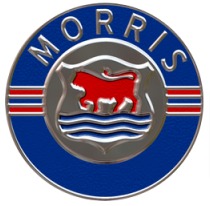
Morris Motors Limited was a British privately owned motor vehicle manufacturing company formed in 1919 to take over the assets of William Morris’s WRM Motors Limited and continue production of the same vehicles. By 1926 its production represented 42 per cent of British car manufacture a remarkable expansion rate attributed to William Morris’s practice of buying in major as well as minor components and assembling them in his own factory. Self-financing through his enormous profits Morris did borrow some money from the public in 1926 and later shared some of Morris Motors’ ownership with the public in 1936 when the new capital was used by Morris Motors to buy many of his other privately held businesses.
WRM Motors Ltd began in 1912 by bicycle manufacturer William Morris. He planned a new light car assembled from bought-in components. A factory was opened in 1913 in Cowley, Oxford, United Kingdom where Morris’s first car, the 2-seat Morris Oxford “Bullnose” was assembled.
In 1914 a coupé and van were added to the line-up, but the Bullnose chassis was too short and the 1018 cc engine too small to make a much-needed 4-seat version of the car. White and Poppe, who made the engine, were unable to supply the volume of units that Morris required, so Morris turned to Continental of Detroit, Michigan for the supply of a 1548 cc engine. Gearboxes and axles were also sourced in the US. In mid-1915 a new larger car, the 2-seat and 4-seat Morris Cowley was introduced. After the war the Continental engine was no longer available so Morris arranged for Hotchkiss of France to make a near copy. This was used to power new versions of the basic Cowley and more up-market Morris Oxford cars.
Morris’s business continued to grow and increase its share of the British market overtaking Ford to become in 1924 the UK’s biggest car manufacturer, holding a 51% share of the home market and remaining enormously profitable. In 1923 Morris bought Hotchkiss’s Coventry business which later became Morris Engines branch. Morris also brought in F G Woollard which became Morris Commercial Cars to lead the re-organization of their engine production from batch to flow, thus increasing output from less than 300 units per week to 1200. By 1924 the factory was making 2000 units a week with only a small increase in work space and labour force. Morris began building sporting versions of Morris cars in 1924 labelling them MG. They were so successful a separate MG factory was soon established in Abingdon, Oxfordshire.
The small car market was entered in 1928 with the Morris Minor, using an 847 cc engine from Morris’s newly acquired Wolseley Motors. The Minor was to provide the base for the MG Midgets. This timely spread into the small car market helped Morris through the economic depression of the 1930s. At the 1934 London Motor Show the Minor was replaced by the Morris Eight.
In July 1935 Morris Motors acquired from W R Morris, now Lord Nuffield, in exchange for a further issue of ordinary shares to him, the car manufacturing businesses of Wolseley Motors Limited and The MG Car Company Limited. A separate private company, Wolseley Aero Engines Limited, was then formed to continue the development of his aviation interests. In 1936 Lord Nuffield sold Morris Commercial Cars Limited, his commercial vehicle enterprise, to Morris Motors. In 1938 William Morris, Baron Nuffield was raised to Viscount Nuffield. The same year he transferred his newly acquired Riley car business to Morris Motors Limited.
Production restarted after the Second World War, with the pre-war Eight and Ten designs. In 1948 the Eight was replaced by what is probably the most famous Morris car, the Morris Minor designed by Alec Issigonis (who later went on to design the Mini) and reusing the small car name from 1928. The Ten was replaced by a new 1948 Morris Oxford MO, styled like a larger version of the Minor. A later Morris Oxford (the 1956 Morris Oxford III) was the basis for the design of India’s Hindustan Ambassador, which continued in production until 2014.
In 1952 the Nuffield Organisation merged with the Austin Motor Company to form the British Motor Corporation (BMC). Nuffield brought the Morris, MG, Riley and Wolseley marques into the merger. Leonard Lord was in charge, which led to Austin’s domination of the organisation. Badge-engineering was important to BMC and for many years the various marques would be seen on several families of similar vehicles.
The Morris marque continued to be used until the early 1980s on cars such as the Morris Marina. The Morris Ital (essentially a facelifted Marina) was the last Morris-badged passenger car, with production ending in the summer of 1984. The last Morris of all was a van variant of the Austin Metro.
The Morris trademark is currently owned by the China-based automotive company SAIC. The Morris badge shows an ox fording the River Isis, the traditional emblem of William Morris’s home town of Oxford, used in the coat of arms of Oxford

